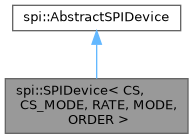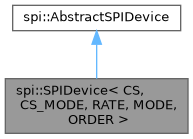Loading...
Searching...
No Matches
spi::SPIDevice< CS, CS_MODE, RATE, MODE, ORDER > Class Template Reference
Base class for any SPI slave device. More...
#include <fastarduino/spi.h>
Inheritance diagram for spi::SPIDevice< CS, CS_MODE, RATE, MODE, ORDER >:

Collaboration diagram for spi::SPIDevice< CS, CS_MODE, RATE, MODE, ORDER >:

Protected Member Functions | |
| SPIDevice () INLINE=default | |
Create a new SPIDevice; this sets up the CS pin for later use during transfers. | |
| void | start_transfer () |
| Start an SPI transfer to this device. More... | |
| void | end_transfer () INLINE |
| End the current SPI ransfer tot hsi device. More... | |
 Protected Member Functions inherited from spi::AbstractSPIDevice Protected Member Functions inherited from spi::AbstractSPIDevice | |
| AbstractSPIDevice (const AbstractSPIDevice &)=delete | |
| AbstractSPIDevice & | operator= (const AbstractSPIDevice &)=delete |
| uint8_t | transfer (uint8_t data) |
| Transfer one byte to the currently selected SPI slave device through MOSI pin, and get the byte returned by the device through MISO pin. More... | |
| void | transfer (uint8_t *data, uint16_t size) |
| Transfer an array of payload data to the currently selected SPI slave device through MOSI pin, and get all data bytes simultaneously received from that device through MISO pin. More... | |
| void | transfer (const uint8_t *data, uint16_t size) |
| Transfer an array of payload data to the currently selected SPI slave device through MOSI pin; any data bytes simultaneously received from that device through MISO pin are lost. More... | |
| void | transfer (uint8_t *data, uint16_t size, uint8_t sent) |
Transfer the provided byte sent several times to the currently selected SPI slave device through MOSI pin, and get all data bytes simultaneously received from that device through MISO pin. More... | |
| void | transfer (uint16_t size, uint8_t sent) |
Transfer the provided byte sent several times to the currently selected SPI slave device through MOSI pin; any data bytes simultaneously received from that device through MISO pin are lost. More... | |
Detailed Description
template<board::DigitalPin CS, ChipSelect CS_MODE = ChipSelect::ACTIVE_LOW, ClockRate RATE = ClockRate::CLOCK_DIV_4, Mode MODE = Mode::MODE_0, DataOrder ORDER = DataOrder::MSB_FIRST>
class spi::SPIDevice< CS, CS_MODE, RATE, MODE, ORDER >
class spi::SPIDevice< CS, CS_MODE, RATE, MODE, ORDER >
Base class for any SPI slave device.
It contains the barebones API for implementing a real device.
Implementing a new SPI device consists mainly in subclassing SPIDevice and add public device-specific methods that will use start_transfer(), transfer() and end_transfer() to communicate with the actual device.
The snippet below illustrates this and summarizes the definition of an SPI based device, the Winbond W25Q80BV flash-memory chip:
template<board::DigitalPin CS>
{
public:
void write_page(uint32_t address, uint8_t* data, uint8_t size)
{
send(0x02, address, data, (size == 0 ? 256 : size));
}
uint8_t read_data(uint32_t address);
void read_data(uint32_t address, uint8_t* data, uint16_t size);
...
private:
void send(uint8_t code, uint32_t address, uint8_t* data, uint16_t size)
{
this->start_transfer();
this->transfer(code);
this->transfer(address >> 16);
this->transfer(address >> 8);
this->transfer(address);
this->transfer(data, size);
this->end_transfer();
}
...
};
- Template Parameters
-
CS the pin used to select the slave device; this may be DigitalPin::NONEif your device is alone on the SPI bus, its CS pin is forced low (always active), and your device actually supports this way of working. Some devices do not like having an always-0 CS pin!CS_MODE the chip select active mode RATE the SPI clock rate for this device MODE the SPI mode used for this device ORDER the bit order for this device
Member Function Documentation
◆ start_transfer()
template<board::DigitalPin CS, ChipSelect CS_MODE = ChipSelect::ACTIVE_LOW, ClockRate RATE = ClockRate::CLOCK_DIV_4, Mode MODE = Mode::MODE_0, DataOrder ORDER = DataOrder::MSB_FIRST>
|
inlineprotected |
◆ end_transfer()
template<board::DigitalPin CS, ChipSelect CS_MODE = ChipSelect::ACTIVE_LOW, ClockRate RATE = ClockRate::CLOCK_DIV_4, Mode MODE = Mode::MODE_0, DataOrder ORDER = DataOrder::MSB_FIRST>
|
inlineprotected |
The documentation for this class was generated from the following file:
- fastarduino/spi.h